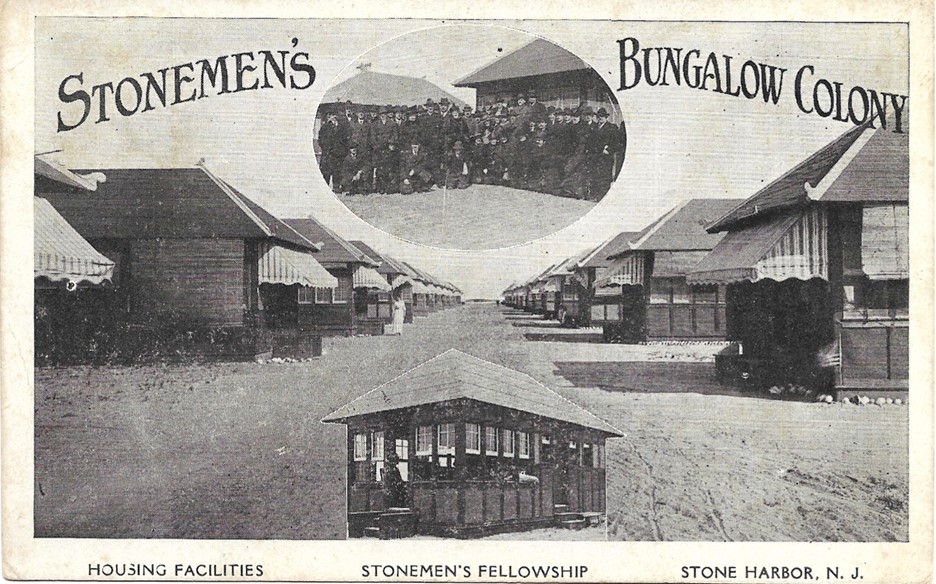Stone Harbor’s Quaint Bungalow Colony : The Early Years
At the beginning, the Risley brothers catered to the well- heeled and wealthy clients of Philadelphia who could afford to build large and expensive homes at the New Stone Harbor. Being astute businessmen, the brothers also recognized a need for a much less pretentious and more modest form of housing and by 1914 this new business initiative led to what became known as the Bungalow Colony. The Risley’s plan was to build and offer small bungalows on small lots arranged originally on two narrow alleyway or “court” streets as they were soon called. These two courts were located at the southern end of the town between 108th street and 111th Street and were named Bower and Weber Courts. Shortly thereafter and due to their immense popularity and affordability, a third alleyway of bungalows was created bearing the name Stone Court. Each court typically had approximately 30 cottages and were located between Third and Second Avenues. The narrow courts were one-way only and vehicles could only drive or proceed eastward from Third Avenue.
Built during 1914-1915, these relatively basic 12-by-24- foot bungalows were auctioned off by the South Jersey Realty Company in 1917. A religious organization known as the Stonemen’s Fellowship purchased all of these cottages and decided to offer them for rent to like-
minded individuals by forming the Stonemen’s Vacation Club. For just a short time Stone Harbor would become the Summer Headquarters of the Stonemen’s Fellowship. These utilitarian four room, fully furnished cottages rented for $4 to $8 weekly during the summer months or for 50-cents nightly. By 1920 these bungalows were selling for around $300 each.
Starting on Saturday, July 28, 1917, realty advertising materials announced “Beautiful, Fully Furnished Bungalows Offered at This Great Auction Sale.” The promotional and descriptive information for that auction went on to state: “These Bungalows, convenient to Channel and bathing beach, are complete in every detail. Electric lighted, sanitary sewerage and daintily furnished with white enamel bed, two woven wire spring mattress cots and linen couch covers, four Crex rugs, dining table, centre table, rocking and straight chairs, quartered oak bureau with plate-glass mirror, shirtwaist box, complete shower bath, porcelain lavatory, vitreous china closet, window shades, wickless blue-flame oil stove, Russian iron oven, ice chest, cooking utensils and dishes. They are the ‘Ford Automobile’ of seashore real estate, complete, practical and inexpensive, rent for from $88 to $128 per year. Built to sell at $1200. Sixty per cent of price bid can remain on mortgage.”
When the U.S. stock market tanked in late 1929, the Great Depression of the 1930s would hit real estate very
hard and consequently we understand the Borough of Stone Harbor ended up foreclosing on these particular bungalow properties. Fast forward and still standing today, most of these little houses have undergone significant second story add-ons along with new porches and decks as well as other major improvements and renovations. Many of the bungalows have also been winterized for year round occupancy and have furnaces for heating comfort. As one source aptly put it, “The quaint charm and timeless appeal of the humble cottages of the Bungalow Colony have helped to define and even reflect the history of the seashore resort known as Stone Harbor”.
As a youngster this author fondly remembers summer vacations when our family rented a nice bungalow at C-7 Weber Court during the late 1950s and early 1960s. There was no telephone, no television and we showered outdoors. I remember the comfort of being lulled to sleep listening to the sound of the ocean surf on some nights. If I were to let nostalgia kick in, I could easily reminisce and readily bring up many very favorable and lasting childhood memories from that time period.
I am attaching here a vintage post card (circa 1917) titled Stonemen’s Bungalow Colony featuring a view of one of the narrow courts lined with rows of similar awninged bungalows as well as including a photo inset
most likely depicting a gathering of the members of the Stonemen’s Fellowship.
In closing, I am happy to report that over the years numerous different picture post cards have been produced and made available for sale depicting the unique Bungalow Colony at Stone Harbor, New Jersey.

